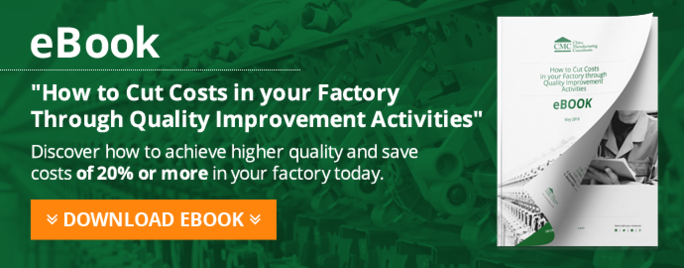In our previous article, we broke down the typical costs of inspection and testing incurred by a Chinese factory, and we noted that they include a significant amount of wasted efforts.
Best-in-class manufacturers have reached a ratio of indirect labor (including office staff and QC inspectors) to direct labor of 1:10. Needless to say, they have very few inspectors on their staff.
David Collins, MTG’s Chief Operations Officer, used to manage a car assembly plant that had zero inspectors. And yet his quality results were among the best of his industry. How did he do that? In good part, with preventive measures (to be discussed in the next articles). And by giving inspection work to the production department...
Is it better to have appraisal done by QC inspectors or by production operators?
This question is often overlooked by manufacturers. Yes, inspection is necessary, even in very good factories. But inspectors are not!
Having production operators spend 10-20% of their time checking quality is much cheaper than having dedicated QC inspectors. There are two reasons for this:
- Those operators already have the product in their hands. No need to carry the parts, grab them, put them back, etc.
- Catching defects closer to the source is always cheaper, and always better for finding the root cause(s) and acting on it, as I wrote above.
Here are the 3 basic principles that every worker MUST adhere to:
- We do not accept bad work;
- We do not do bad work;
- When we do bad work, we put it aside (or we follow a pre-established procedure).
Is this realistic in China?
A common obstacle to this approach is the practice of paying operators by the piece. It is quite common in China, Vietnam, and many other Asian countries. Managers like this because the have no need to “motivate” production staff, and operators like it because it is a clear path to earning more.
The worker’s incentive in this system is to make as many pieces as possible, and they only focus on “making production”. This is compounded by the lack of traceability at the individual piece level (it is not clear who made the defects, so repairing is spread over several operators).
We are strong advocates of paying operators by the hour, but a factory can take intermediate steps in that direction – for example paying operators based on the good pieces (not just any piece) made by their team (not just by themselves). This is quite realistic and has been a part of many of our projects.
How do production operators check their own work?
We see many factories where operators do their processing and then check the part they worked on. This is good for checking if they do a good job. But there is a lack of “distance” that might induce incorrect conclusions.
A good alternative is successive inspection. It works this way:
I grab the part, I check it, I process it, and I put it down.
Conclusion
In summary, a way to reduce inspection and testing costs, while keeping the ability to catch issues intact, is to give a part of that job to production operators. At the end of the day, the production department is responsible for product quality, as it should be!
What are your thoughts on production operators performing at least a part of the QC process?
Please let us know your questions and feedback by leaving a comment below.




